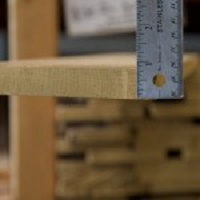Lumber Dimensions

Why is a 2 x 4 not 2 inches by 4 inches?
Its always confusing when you go to the lumber store, buy your wood, come home and look at your pattern which calls for wood 2 #inches thick. Great you think as I just bought a 2×4 piece of lumber.
Huh. It only measures 1 1/2 inches. Whats up?
Luckily most patterns account for the difference in size from the advertised size to the actual size.
When the lumber (softwood lumber) is cut from the tree it is actually the size that is advertised (2×4). But lumber must be dried to remove the moisture content (sap) otherwise it would be shrinking on you after you have built your project. So by the time the moisture is removed and they smooth out both sides so they look good, about 1/2 an inch is lost.
Here is a chart for what the Actual size of Softwood lumber is when we get it home.
Scroll down further for Hardwood sizing.
Nominal Actual Actual – Metric 1″ x 2″ 3/4″ x 1-1/2″ 19 x 38 mm 1″ x 3″ 3/4″ x 2-1/2″ 19 x 64 mm 1″ x 4″ 3/4″ x 3-1/2″ 19 x 89 mm 1″ x 5″ 3/4″ x 4-1/2″ 19 x 114 mm 1″ x 6″ 3/4″ x 5-1/2″ 19 x 140 mm 1″ x 7″ 3/4″ x 6-1/4″ 19 x 159 mm 1″ x 8″ 3/4″ x 7-1/4″ 19 x 184 mm 1″ x 10″ 3/4″ x 9-1/4″ 19 x 235 mm 1″ x 12″ 3/4″ x 11-1/4″ 19 x 286 mm 1-1/4″ x 4″ 1″ x 3-1/2″ 25 x 89 mm 1-1/4″ x 6″ 1″ x 5-1/2″ 25 x 140 mm 1-1/4″ x 8″ 1″ x 7-1/4″ 25 x 184 mm 1-1/4″ x 10″ 1″ x 9-1/4″ 25 x 235 mm 1-1/4″ x 12″ 1″ x 11-1/4″ 25 x 286 mm 1-1/2″ x 4″ 1-1/4″ x 3-1/2″ 32 x 89 mm 1-1/2″ x 6″ 1-1/4″ x 5-1/2″ 32 x 140 mm 1-1/2″ x 8″ 1-1/4″ x 7-1/4″ 32 x 184 mm 1-1/2″ x 10″ 1-1/4″ x 9-1/4″ 32 x 235 mm 1-1/2″ x 12″ 1-1/4″ x 11-1/4″ 32 x 286 mm 2″ x 2″ 1-1/2″ x 1-1/2″ 38 x 38 mm 2″ x 4″ 1-1/2″ x 3-1/2″ 38 x 89 mm 2″ x 6″ 1-1/2″ x 5-1/2″ 38 x 140 mm 2″ x 8″ 1-1/2″ x 7-1/4″ 38 x 184 mm 2″ x 10″ 1-1/2″ x 9-1/4″ 38 x 235 mm 2″ x 12″ 1-1/2″ x 11-1/4″ 38 x 286 mm 3″ x 6″ 2-1/2″ x 5-1/2″ 64 x 140 mm 4″ x 4″ 3-1/2″ x 3-1/2″ 89 x 89 mm 4″ x 6″ 3-1/2″ x 5-1/2″ 89 x 140 mm
Hardwood Lumber is sized differently that Softwood. The thickness is defined every 1/4 inch. So a 1/4 is 1/4inch thick and a 2/4 is 1/2 inch thick and so on. So a 5/4 is 1 1/4 inches thick.
Hardwood lumber is sold differently that softwood, so there is usually not a 2×4 piece. The reasoning is that there would be too much waste at the mill so they cut the lumber based on the size of the tree.
Here is a chart for Hardwood dimensions.
| Nominal (rough-sawn size) | S1S (surfaced on one side) | S2S (surfaced on two sides) |
|---|---|---|
| 1⁄2 in | 3⁄8 in (9.5 mm) | 5⁄16 in (7.9 mm) |
| 5⁄8 in | 1⁄2 in (13 mm) | 7⁄16 in (11 mm) |
| 3⁄4 in | 5⁄8 in (16 mm) | 9⁄16 in (14 mm) |
| 1 in or 4⁄4 in | 7⁄8 in (22 mm) | 13⁄16 in (21 mm) |
| 1 1⁄4 in or 5⁄4 in | 1 1⁄8 in (29 mm) | 1 1⁄16 in (27 mm) |
| 1 1⁄2 in or 6⁄4 in | 1 3⁄8 in (35 mm) | 1 5⁄16 in (33 mm) |
| 2 in or 8⁄4 in | 1 13⁄16 in (46 mm) | 1 3⁄4 inches (44 mm) |
| 3 in or 12⁄4 in | 2 13⁄16 in (71 mm) | 2 3⁄4 in (70 mm) |
| 4 in or 16⁄4 in | 3 13⁄16 in (97 mm) | 3 3⁄4 in (95 mm) |
In short, these fractions are the names for the thickness of hardwood lumber. The thickness is expressed as a fraction, and goes in increments of quarters of an inch. However, this is a name only. It’s not a precise measurement

